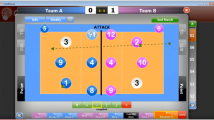Abstract
Considering player entity’s motion regularity into DR (Dead Reckoning) algorithm can improve its prediction accuracy in MMOG (Massively Multiplayer Online Games), a novel DR algorithm was proposed to solve this problem in this paper. First the artificial potential field model of player entities is created, and then the acceleration of player entities is weighted with the acceleration produced by the potential field force and the acceleration reckoned by the traditional DR algorithm. In order to calculate the weight, Q-Learning algorithm is used. The experiments show that the method can improve prediction accuracy and reduce the network traffic.







Similar content being viewed by others
References
Bridle JS (1990) Training stochastic model recognition algorithms as networks can lead to maximum mutual information estimates of parameters. In: Touretzky DS (ed) Advances in neural information processing systems 2. Morgan Kaufmann, San Francisco, pp 211–217
Delaney D, Ward T, McLoone S (2003) Reducing update packets in distributed interactive applications using a hybrid approach. ISCA PDCS 2003:417–422
Delaney D, McLoone S, Ward T (2005) A novel convergence algorithm for the hybrid strategy model packet reduction technique. IEE ISSC 2005:118–123
Khatib O (1986) Real-time obstacle avoidance for manipulators and mobile robots. Int J Robot Res 5(1):90–98. doi:10.1177/027836498600500106
Kim HG, Kim SW (2005) An improvement of dead reckoning algorithm using Kalman filter for minimizing network traffic of 3D on-line games. Adv Multimedia Inf Process – PCM 2005 3768:676–687. doi:10.1007/11582267_59
Madden D, Delaney D, McLoone S, Ward T (2004) Visibility path-finding in relation to hybrid strategy-based models in distributed interactive applications. DS-RT 2004:91–97
Madden D, Delaney D, McLoone S, Ward T (2004) Exploring the spatial density of strategy models in a realistic distributed interactive application. DS-RT 2004:210–213
Marshall D, McCoy A, Delaney D, Ward T (2004) A realistic distributed interactive application testbed for static and dynamic entity state data acquisition. IEE ISSC 2004:83–88
McCoy A, Delaney D, McLoone S, Ward T (2004) Towards statistical client prediction—analysis of user behavior in distributed interactive media. CGAIDE 2004:144–149
McCoy A, Ward T, McLoone S, Delaney D (2006) Using neural-networks to reduce entity state updates in distributed interactive applications. Mach Learn Signal Process 2006:295–300. doi:10.1109/MLSP.2006.275564
McCoy A, Ward T, McLoone S, Delaney D (2007) Multistep-ahead neural-network predictors for network traffic reduction in distributed interactive applications. Trans Model Comput Simul 17(4):1–30
Singhal SK, Cheriton DR (1995) Exploiting position history for efficient remote rendering in networked virtual reality. Presence Teleoper Virtual Environ 4(2):169–193
Sutton RS, Barto AG (1998) Reinforcement learning: an introduction. MIT, Cambridge, MA
Watkin CJ, Dayan P (1992) Q learning. Mach Lang 8:279–292
Yang M, Zhang B, Ma P, Wang ZC (2000) Research on improving dead reckoning model in DIS. J Syst Simul 12(5):439–441
Yang HY, You ZS, Zhang JW, Yu B (2000) Research on dead reckoning algorithms in distributed air-ground interactive simulation systems. J Comput Res Dev 37:954–961
Acknowledgements
This paper was supported by a grant from the Natural Science Foundation of Liaoning Province of China (20052007) and Foundation of Liaoning Educational Committee (2004D116).
Special thanks to colleagues in our lab helped us in experimental design.
Author information
Authors and Affiliations
Corresponding author
Rights and permissions
About this article
Cite this article
Shi, XB., Wang, X., Bi, J. et al. A DR algorithm based on artificial potential field method. Multimed Tools Appl 45, 247–261 (2009). https://doi.org/10.1007/s11042-009-0296-6
Published:
Issue Date:
DOI: https://doi.org/10.1007/s11042-009-0296-6




